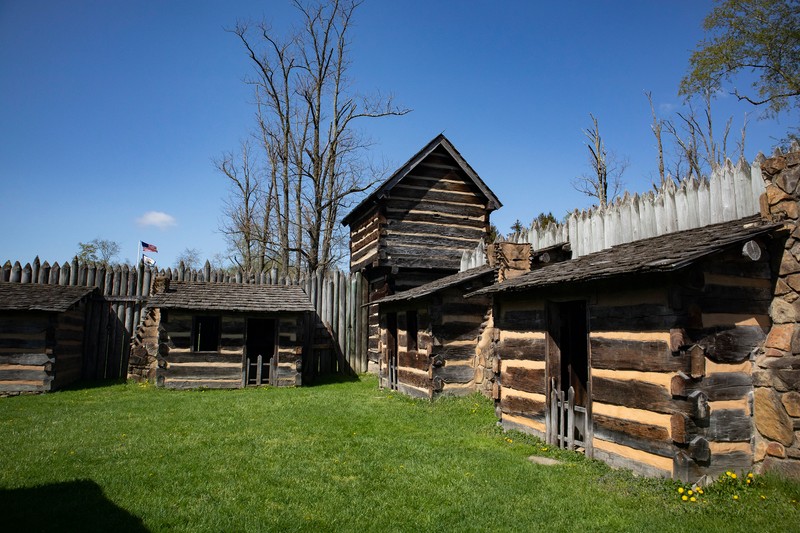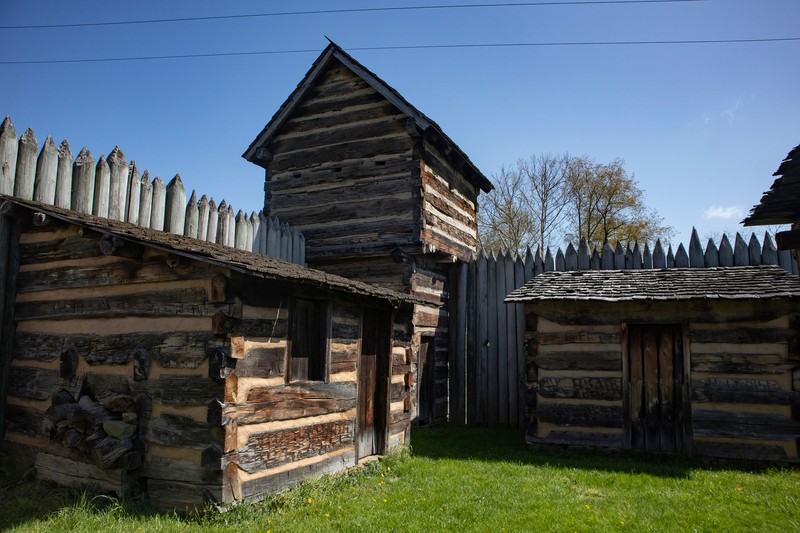Inside the Fort: Cabins and Blockhouses
Introduction
Text-to-speech Audio
The reconstructed Pricketts Fort has distinct features including four blockhouses on each corner and 16 small, interior cabins. The blockhouses were used to store supplies and served as lookouts. The cabins provided shelter for civilians seeking refuge at the fort, as well as militia members stationed at the fort. These features represent how the fort was a defensive structure for both civilians and the militia.
Images
Blockhouses stored supplies and would have been used as lookouts by the militia. Small cabins provided shelter for civilians seeking refuge or militia members stationed at the fort.

Another view of a blockhouse and two cabins.

Backstory and Context
Text-to-speech Audio
Tensions between settlers and Indigenous people came to a head during Dunmore’s War, the main driving force behind the construction of Pricketts Fort and formation of a local militia in 1774. Both the militia and the fort aimed to protect civilians in this remote part of the Virginia colony. The reconstructed blockhouses and cabins speak to how the fort housed resources for the militia’s defenses and provided refuge for civilians.
While there is not a definitive description of the original Pricketts Fort, the reconstruction’s design draws from research on other 18th century forts. Both the blockhouses and cabins have logs with daub, a clay mixture, between them to provide insulation.
The blockhouses on each of the four corners of the fort are a defining feature of the reconstruction’s design. Unlike standalone blockhouses, these blockhouses are incorporated in the fort’s overall structure. They stood as a lookout and served as a last defensive position if the stockade walls were breached.
The militia comprised boys as young as 16 and men as old as 60, who attended drills once a month. There were at least four militia units that were stationed at Prickett’s Fort during the 1770s and 1780s, one of which stayed during the winter
Civilians “forted up” when the threat of attacks by Native Americans was imminent. Up to 200-250 people could be at the fort at one time. While Pricketts Fort was one of the largest forts in the Monongahela Valley, it could not house everyone within the stockade walls. Some residents built lean-to style huts outside the stockade walls, so they could at least be close to the fort and head inside if the area was attacked.
The 16 small cabins represent the hundreds of civilians who took refuge in the fort. Today, the cabins are furnished with reproduction personal belongings, such as blankets, clothing, trunks, pottery, and other items of value. Each cabin has a chimney made of stone, wood, and clay, which was common for new construction in the 18th century because quarrying stone was labor-intensive and time-consuming. During special events, reenactors often stay in the cabins and demonstrate how they were historically used.
Sources
Boback, John M. Pricketts Fort: A Bastion in the Wilderness. Pricketts Fort Memorial Foundation, 2005.
Bray, Greg. Images of America: Pricketts Fort. Charleston, SC. Arcadia Publishing, 2014.
The Fort, Pricketts Fort Memorial Foundation. Accessed May 31st 2022. https://www.prickettsfort.org/fort.html.
Hendricks, R. F. "Fort Stanwix Treaties." e-WV: The West Virginia Encyclopedia. 30 July 2012. Web. 31 May 2022. https://www.wvencyclopedia.org/articles/2056
May, Melissa "Pricketts Fort." e-WV: The West Virginia Encyclopedia. 22 October 2010. Web. 31 May 2022. https://www.wvencyclopedia.org/articles/1919
McBride, Kim and Stephen McBride "Frontier Defense." e-WV: The West Virginia Encyclopedia. 23 April 2013. Web. 31 May 2022. https://www.wvencyclopedia.org/articles/2075
Native Americans in West Virginia, Pricketts Fort Memorial Foundation. Accessed May 31st 2022. https://www.prickettsfort.org/native-americans-in-west-virginia.html
Sturm, Philip "Dunmore’s War." e-WV: The West Virginia Encyclopedia. 07 November 2010. Web. 31 May 2022.https://www.wvencyclopedia.org/articles/1982
Wilcox, William J. Pricketts Fort: How and Why it Came to Be. Pricketts Fort Memorial Foundation. Reprinted 2011.
Courtesy of Pamela Curtin, Clio Foundation
Courtesy of Pamela Curtin, Clio Foundation
